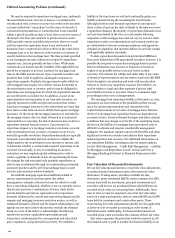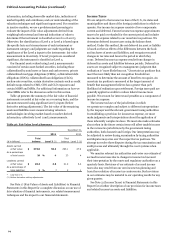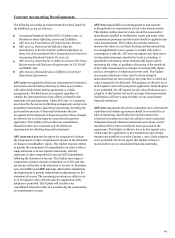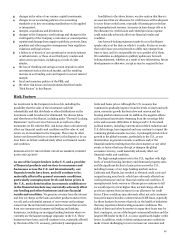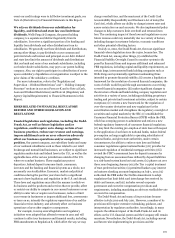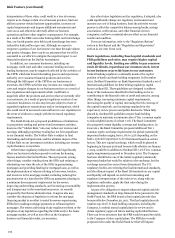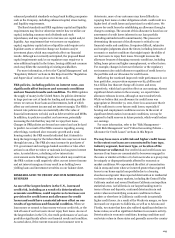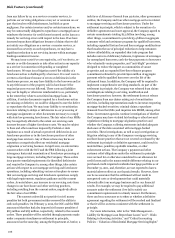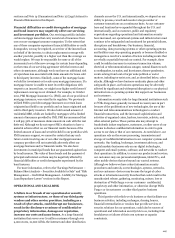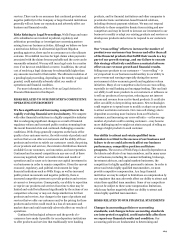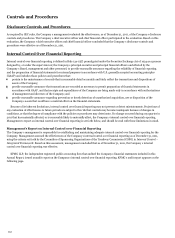Wells Fargo 2011 Annual Report Download - page 104
Download and view the complete annual report
Please find page 104 of the 2011 Wells Fargo annual report below. You can navigate through the pages in the report by either clicking on the pages listed below, or by using the keyword search tool below to find specific information within the annual report.Risk Factors (continued)
interpretation of those rules, could result in a loss of revenue,
require us to change certain of our business practices, limit our
ability to pursue certain business opportunities, increase our
capital requirements and impose additional assessments and
costs on us and otherwise adversely affect our business
operations and have other negative consequences. For example,
as a result of the FRB’s new rules limiting debit card interchange
fees, our fourth quarter 2011 debit card interchange fees were
reduced by $365 million (pre-tax). Although we expect to
recapture a portion of our lost income over time through volume
and product changes, there can be no assurance that we will be
successful in our efforts to mitigate the negative impact to our
financial results from the Durbin Amendment.
In addition, our consumer businesses, including our
mortgage, credit card and other consumer lending and non-
lending businesses, may be negatively affected by the activities of
the CFPB, which has broad rulemaking powers and supervisory
authority over consumer financial products and services.
Although the full impact of the CFPB on our businesses is
uncertain, the CFPB’s activities may increase our compliance
costs and require changes in our business practices as a result of
new regulations and requirements which could limit or
negatively affect the products and services that we currently offer
our customers. As a result of greater regulatory scrutiny of our
consumer businesses, we also may become subject to more or
expanded regulatory examinations and/or investigations, which
also could result in increased costs and harm to our reputation in
the event of a failure to comply with the increased regulatory
requirements.
The Dodd-Frank Act’s proposed prohibitions or limitations
on proprietary trading and private fund investment activities,
known as the “Volcker Rule,” also may reduce our revenue and
earnings, although proprietary trading has not been significant
to our financial results. The Volcker Rule is subject to final
rulemaking and interpretation, and the ultimate impact of the
Volcker Rule on our investment activities, including our venture
capital business, is uncertain.
Other future regulatory initiatives that could significantly
affect our business include proposals to reform the housing
finance market in the United States. These proposals, among
other things, consider winding down the GSEs and reducing or
eliminating over time the role of the GSEs in guaranteeing
mortgages and providing funding for mortgage loans, as well as
the implementation of reforms relating to borrowers, lenders,
and investors in the mortgage market, including reducing the
maximum size of a loan that the GSEs can guarantee, phasing in
a minimum down payment requirement for borrowers,
improving underwriting standards, and increasing accountability
and transparency in the securitization process. As recently
proposed by the Obama administration, Congress also may
consider the adoption of legislation to reform the mortgage
financing market in an effort to assist borrowers experiencing
difficulty in making mortgage payments or refinancing their
mortgages. The extent and timing of any regulatory reform or the
adoption of any legislation regarding the GSEs and/or the home
mortgage market, as well as any effect on the Company’s
business and financial results, are uncertain.
Any other future legislation and/or regulation, if adopted, also
could significantly change our regulatory environment and
increase our cost of doing business, limit the activities we may
pursue or affect the competitive balance among banks, savings
associations, credit unions, and other financial services
companies, and have a material adverse effect on our financial
results and condition.
For more information, refer to the “Regulatory Reform”
section in this Report and the “Regulation and Supervision”
section in our 2011 Form 10-K.
Bank regulations, including Basel capital standards and
FRB guidelines and rules, may require higher capital
and liquidity levels, limiting our ability to pay common
stock dividends, repurchase our common stock, invest
in our business or provide loans to our customers.
Federal banking regulators continually monitor the capital
position of banks and bank holding companies. In December
2010, the Basel Committee on Bank Supervision finalized a set of
international guidelines for determining regulatory capital
known as Basel III. These guidelines are designed to address
many of the weaknesses identified in the banking sector as
contributing to the financial crisis of 2008 and 2009 by, among
other things, increasing minimum capital requirements,
increasing the quality of capital, increasing the risk coverage of
the capital framework, and increasing standards for the
supervisory review process and public disclosure. When fully
phased in, the Basel III guidelines require bank holding
companies to maintain a minimum ratio of Tier 1 common equity
to risk-weighted assets of at least 7.0%. The Basel Committee
also proposed certain liquidity coverage and funding ratios. In
June 2011, the Basel Committee proposed additional Tier 1
common equity surcharge requirements for global systemically
important banks ranging from 1.0% to 3.5% depending on the
bank’s systemic importance to be determined based on certain
factors. This new capital surcharge, which would be phased in
beginning in January 2016 and become fully effective on January
1, 2019, would be in addition to the Basel III 7.0% Tier 1 common
equity requirement proposed in December 2010. The Company
has been identified as one of the initial 29 global systemically
important banks that would be subject to the surcharge, but the
surcharge amount has not yet been determined. The U.S.
regulatory bodies are reviewing the final international standards,
and the ultimate impact of the Basel III standards on our capital
and liquidity will depend on such final rulemaking and
regulatory interpretations of the rules as we, along with our
regulatory authorities, apply the final rules during the
implementation process.
As part of its obligation to impose enhanced capital and risk-
management standards on large financial firms pursuant to the
Dodd-Frank Act, the FRB issued a final capital plan rule that
became effective December 30, 2011. The final capital plan rule
requires top-tier U.S. bank holding companies, including the
Company, to submit annual capital plans for review and to
obtain regulatory approval before making capital distributions.
There can be no assurance that the FRB would respond favorably
to the Company’s future capital plans. The FRB also recently
proposed rules under the Dodd-Frank Act that will impose
102


